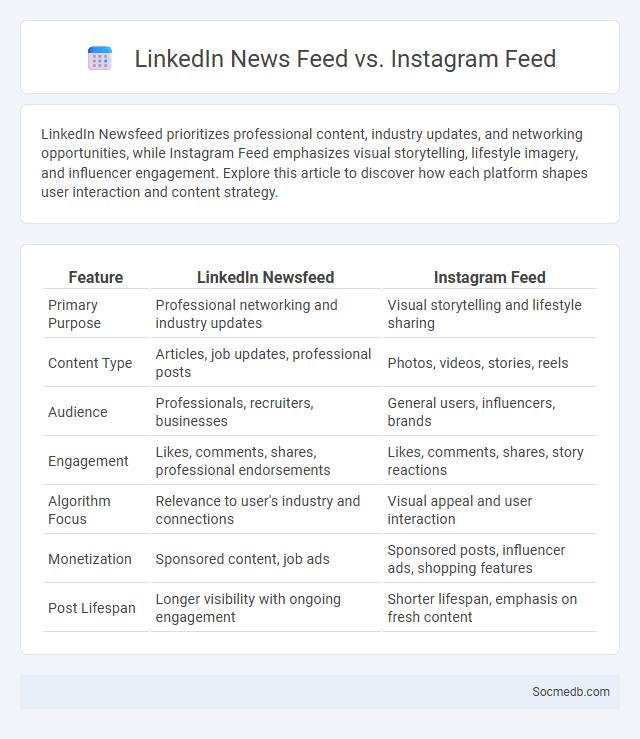
Photo illustration: LinkedIn Newsfeed vs Instagram Feed
LinkedIn Newsfeed prioritizes professional content, industry updates, and networking opportunities, while Instagram Feed emphasizes visual storytelling, lifestyle imagery, and influencer engagement. Explore this article to discover how each platform shapes user interaction and content strategy.
Table of Comparison
| Feature | LinkedIn Newsfeed | Instagram Feed |
|---|---|---|
| Primary Purpose | Professional networking and industry updates | Visual storytelling and lifestyle sharing |
| Content Type | Articles, job updates, professional posts | Photos, videos, stories, reels |
| Audience | Professionals, recruiters, businesses | General users, influencers, brands |
| Engagement | Likes, comments, shares, professional endorsements | Likes, comments, shares, story reactions |
| Algorithm Focus | Relevance to user's industry and connections | Visual appeal and user interaction |
| Monetization | Sponsored content, job ads | Sponsored posts, influencer ads, shopping features |
| Post Lifespan | Longer visibility with ongoing engagement | Shorter lifespan, emphasis on fresh content |
Understanding the Essence of Each Newsfeed
Each social media platform curates a unique newsfeed shaped by sophisticated algorithms analyzing your interactions, preferences, and trending topics. Understanding the essence of each newsfeed helps you filter relevant content, ensuring your time online is engaging and meaningful. Tailoring your feed settings empowers you to control the flow of information, enhancing your digital experience.
Key Differences Between LinkedIn and Instagram Feeds
LinkedIn feeds emphasize professional content, showcasing industry news, job updates, and thought leadership articles targeted at career development and networking. Instagram feeds prioritize visual storytelling through images and short videos, promoting lifestyle, personal brand, and entertainment-focused content. The algorithm on LinkedIn favors engagement through comments and shares on professional insights, while Instagram's algorithm boosts posts based on likes, views, and user interaction with multimedia content.
Audience Demographics: LinkedIn vs Instagram vs General Newsfeeds
LinkedIn's audience predominantly consists of professionals aged 25-45, with a strong emphasis on B2B connections and industry-specific content, making it ideal for networking and career growth. Instagram attracts a younger demographic, primarily users aged 18-34, favoring visual content that drives engagement through lifestyle, fashion, and entertainment niches. Understanding your target audience's platform preference enables you to tailor content effectively across LinkedIn, Instagram, and general newsfeeds, maximizing reach and impact.
Content Types: What Performs Best on Each Platform?
Instagram thrives on high-quality visuals such as photos, Stories, and Reels that engage users through creative imagery and short-form videos. On Facebook, a mix of videos, curated articles, and interactive posts like polls generates strong user interaction and shares. Twitter's real-time nature favors concise text updates, news links, and trending hashtags, while TikTok dominates with authentic, entertaining short videos that capitalize on viral challenges and music trends.
Engagement Patterns Across LinkedIn, Instagram, and Newsfeeds
Engagement patterns vary significantly across LinkedIn, Instagram, and newsfeeds, with LinkedIn favoring professional content such as industry insights and networking posts that drive meaningful interactions among business users. Instagram emphasizes visual storytelling through images and short videos, generating high engagement via likes, comments, and shares among younger demographics. Newsfeeds incorporate a mix of algorithmically personalized content including news articles, advertisements, and social updates to maximize user retention and interaction rates.
Algorithm Insights: How Each Feed Prioritizes Content
Social media algorithms analyze your interactions, such as likes, comments, and shares, to prioritize content that matches your interests and engagement patterns. Each platform uses unique metrics: Instagram favors recent posts and stories, while Facebook emphasizes meaningful interactions between friends and groups. Understanding these algorithm insights helps you tailor your content strategy to boost visibility and engagement effectively.
Visual vs Professional: Tone and Style Comparison
Social media platforms require distinct tone and style approaches, with visual content favoring vibrant, eye-catching imagery and casual, engaging captions that appeal to a broad audience. Professional content emphasizes clarity, formality, and informative text, often supported by clean graphics or branded visuals to establish credibility. Your choice between visual and professional tone should align with your brand's goals and the expectations of your target audience for maximum impact.
Advertising Opportunities and Promotion Strategies
Social media platforms offer diverse advertising opportunities including targeted ads, influencer partnerships, and sponsored content that precisely reach specific demographics. Utilizing advanced algorithms, advertisers can optimize campaigns to increase engagement, conversions, and brand awareness through personalized promotions. Effective promotion strategies leverage real-time analytics, audience insights, and multi-channel integration to maximize return on investment and enhance customer interaction.
Measuring Success: Analytics and Performance Metrics
Measuring success on social media involves analyzing key performance metrics such as engagement rate, reach, impressions, and follower growth. Utilizing tools like Google Analytics, Facebook Insights, and Twitter Analytics helps track content effectiveness and audience behavior in real-time. Data-driven evaluation enables refinement of social media strategies to maximize ROI and brand visibility.
Choosing the Right Feed for Your Content Goals
Selecting the right social media feed aligns your content with platforms where your target audience is most active, enhancing engagement and reach. You must assess the unique features and demographics of feeds like Instagram's visual focus, Twitter's real-time updates, or LinkedIn's professional networking to match your content goals effectively. Optimizing your strategy by targeting the appropriate feed ensures your message resonates and achieves maximum impact.
 socmedb.com
socmedb.com